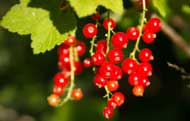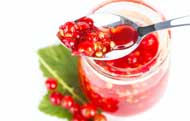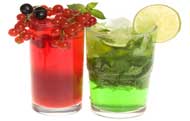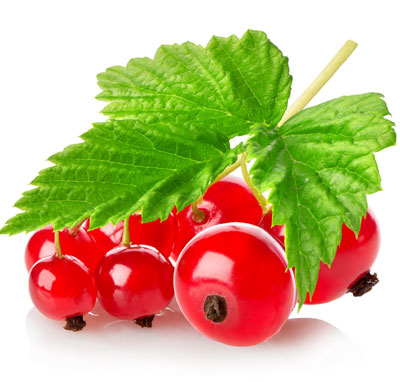





1. Redcurrent Facts
2. Types of Redcurrents
3. Nutritional Value of Redcurrents
4. Health Benefits of Redcurrents
The redcurrant or red currant (Ribes rubrum) is a member of the genus Ribes in the family Grossulariaceae. It is native to western Europe. The species is widely cultivated and has escaped into the wild in many regions.
The redcurrant or red currant (Ribes rubrum) is a member of the genus Ribes in the family Grossulariaceae. The species is native to western Europe. Ribes rubrum is a deciduous shrub normally growing to 1–1.5 metres (3+1⁄2–5 feet) tall, occasionally 2 m (7 ft), with five-lobed leaves arranged spirally on the stems. The flowers are inconspicuous yellow green, in pendulous 4–8-centimetre (1+1⁄2–3+1⁄4-inch) racemes, maturing into bright red translucent edible berries about 8–12 millimetres (3⁄8–1⁄2 in) diameter; the wild plant has 3–10 berries on each raceme. The plant is self-pollinating but produces more fruit when pollinated by another plant of a different variety. An established bush can produce 3–4 kilograms (6+1⁄2–8+3⁄4 pounds) of berries from mid- to late summer.
Phytochemicals - Redcurrant fruits are known for their tart flavour, a characteristic provided by a relatively high content of organic acids and mixed polyphenols. As many as 65 different phenolic compounds may contribute to the astringent properties of redcurrants, with these contents increasing during the last month of ripening. Twenty-five individual polyphenols and other nitrogen-containing phytochemicals in redcurrant juice have been isolated specifically with the astringent flavour profile sensed in the human tongue.
History and Origin
Red currants originated in Europe and Asia and have been consumed since ancient times. Their systematic cultivation began in the Netherlands and Denmark in the 16th century, spreading to other parts of Europe, where they were used for food and drink.
- • Jonkheer van Tets
- • Rovada
- • Perfection
Commonly grown and sold red currant varieties in Australia include 'Jonkheer van Tets', 'Rovada', and 'Perfection', along with other named and unnamed cultivars grown for their fruit. These varieties are available in nurseries and garden centres, and some are considered more resistant to pests like mildew and aphids.
Popular red currant varieties
Jonkheer van Tets: Known for being one of the first to ripen, with large, bright red fruits and a heavy yield.
Rovada: A promising cultivar that produces large clusters of fruit with excellent eating quality.
Perfection: Another named variety, often sold in nurseries.
Other varieties: Unnamed or regionally adapted red currants are also sold.
Where to find them
Nurseries and garden centres: These are the most common places to buy red currant bushes, which can be purchased in pots or as bare-root plants.
Online retailers: Many specialist nurseries and garden suppliers sell red currants online.
Fruit ” Redcurrent ” ( Nutritional value )
Nutritional value per 100 g
Currants, red and white, raw
|
Nutrient ( Proximate’s )
|
Unit
|
Value
|
Daily Value %
|
|
Energy
|
kcal
|
56
|
2.8%
|
|
Protein
|
g
|
1.40
|
2.8%
|
|
Total lipid (fat)
|
g
|
0.20
|
0.2%
|
|
Carbohydrate, by difference
|
g
|
13.80
|
5%
|
|
Fiber, total dietary
|
g
|
4.3
|
17.2%
|
|
Sugars, total
|
g
|
7.37
|
|
|
Minerals
|
|||
|
Calcium, Ca
|
mg
|
33
|
2.5%
|
|
Iron, Fe
|
mg
|
1.00
|
5.5%
|
|
Magnesium, Mg
|
mg
|
13
|
3%
|
|
Phosphorus, P
|
mg
|
44
|
3.5%
|
|
Potassium, K
|
mg
|
275
|
5.8%
|
|
Sodium, Na
|
mg
|
1
|
0.04%
|
|
Zinc, Zn
|
mg
|
0.23
|
2%
|
|
Copper, Cu
|
mg
|
0.107
|
11.8%
|
|
Manganese, Mn
|
mg
|
0.186
|
8%
|
|
Selenium, Se
|
mcg
|
0.6
|
1%
|
|
Vitamins
|
|||
|
Vitamin C, total ascorbic acid
|
mg
|
41.0
|
45.5%
|
|
Thiamin (B-1)
|
mg
|
0.040
|
3.3%
|
|
Riboflavin (B-2)
|
mg
|
0.050
|
3.8%
|
|
Niacin (B-3)
|
mg
|
0.100
|
0.6%
|
|
Pantothenic acid (B-5)
|
mg
|
0.064
|
1.2%
|
|
Vitamin B-6
|
mg
|
0.070
|
4.1%
|
|
Vitamin B-12
|
mg
|
0.00
|
|
|
Folate DFE (dietary folate) (B-9)
|
mcg
|
8
|
2%
|
|
Vitamin A, RAE (retinol)
|
mcg
|
2
|
0.2%
|
|
Vitamin E (alpha-tocopherol)
|
mg
|
0.10
|
0.6%
|
|
Vitamin D (D2 + D3)
|
mcg
|
0
|
|
|
Vitamin K (phylloquinone)
|
mcg
|
11.0
|
9.1%
|
|
Lipids
|
|||
|
Saturated Fatty Acids
|
g
|
0.017
|
0.08%
|
|
Monounsaturated Fatty Acids
|
g
|
0.028
|
|
|
Polyunsaturated Fatty Acids
|
g
|
0.088
|
|
|
Trans Fatty Acids
|
g
|
0.000
|
|
|
Carotenoids
|
|||
|
Beta-Carotene
|
mcg
|
25
|
|
|
Beta-Cryptoxanthin
|
mcg
|
0
|
|
|
Lutein + zeaxanthin
|
mcg |
47
|
|

|
Reference Values are based on a 2,000 Calorie Intake, for Adults and Children 4 or More Years of Age. Your daily values may be higher or lower depending on your calorie needs.
|
|
Percentages are roughly approximated using (RDA) Recommended Dietary Allowances for adults. Source: Nutrient Database – USDA (United States Department of Agriculture)
|
|
Reference Values for Nutrition – FDA U.S. Food and Drug Administration
|
Redcurrent Nutritional Value
Redcurrants are highly nutritious, providing vitamins, fiber, and antioxidants that support cardiovascular health, a strong immune system, and healthy digestion. They contain vitamin C for immune support, vitamin E and other antioxidants to protect against cell damage, and fiber for digestive health. Redcurrants also contain potassium, which can help regulate blood pressure, and have properties that may support bone health and skin health.
- SKIN AND BONE HEALTH
Support both skin and bone health due to their rich content of vitamins, minerals, and antioxidants. They are particularly high in vitamin C, which promotes collagen production for skin and is an antioxidant that protects against damage. They also provide vitamin K and minerals like manganese, potassium, and phosphorus, which are all crucial for maintaining strong and healthy bones. - HIGH IN FIBER
Redcurrants are a good source of fiber, with about 4.3 to 4.8 grams of dietary fiber per 100g serving. This makes them beneficial for digestive health, promoting satiety, and helping to manage blood sugar and cholesterol levels. - HAVE ANTI-INFLAMMATORY EFFECTS
Redcurrants have anti-inflammatory effects due to their high content of antioxidants, such as anthocyanins and flavonoids, which help combat inflammation in the body. These compounds work to regulate inflammatory responses, potentially reducing the risk of chronic diseases. - RICH IN VITAMINS AND MINERALS
Redcurrants are rich in vitamins, minerals, and antioxidants, making them a very nutritious fruit. They are particularly high in Vitamin C, which supports immune function, and also contain Vitamin K, Vitamin E, and various B vitamins. Additionally, redcurrants provide essential minerals like potassium, iron, magnesium, and phosphorus, and are an excellent source of antioxidants such as anthocyanins and flavonoids.

- OFFER IMMUNE SUPPORT
Redcurrants offer immune support mainly due to their high content of vitamin C and other antioxidants like anthocyanins. Vitamin C is crucial for a healthy immune system, and antioxidants help protect the body's cells from damage. They also provide vitamin K and minerals like manganese, potassium, and phosphorus, which are all crucial for maintaining strong and healthy bones. - OFFER ANTIOXIDANT PROTECTION
Redcurrants offer antioxidant protection by providing a range of beneficial compounds like vitamin C, flavonoids, and anthocyanins that help neutralize free radicals, reduce oxidative stress, and fight inflammation. This can help protect cells from damage and may lower the risk of chronic diseases. - SUPPORT DIGESTIVE HEALTH
Redcurrants support digestive health due to their high fiber content, which promotes bowel regularity and acts as a prebiotic to nourish beneficial gut bacteria. They also contain organic acids that may have a mild laxative effect, helping to improve intestinal transit and relieve constipation. - SUPPORT CARDIOVASCULAR HEALTH
Redcurrants support cardiovascular health due to their high levels of antioxidants, fiber, and nutrients like potassium, vitamin C, and folic acid. These components help by lowering blood pressure, reducing inflammation, and protecting against oxidative stress, which can decrease the risk of heart disease and stroke.
References
Nutrient Database – USDA (United States Department of Agriculture)
Reference Values for Nutrition – FDA U.S. Food and Drug Administration
Rich in vitamins and minerals - Redcurrants are rich in vitamins, minerals, and antioxidants, making them a nutritious fruit. They are particularly high in Vitamin C, which supports immune function, and also contain Vitamin K, Vitamin E, and various B vitamins. Additionally, redcurrants provide essential minerals like potassium, iron, magnesium, and phosphorus, and are an excellent source of antioxidants such as anthocyanins and flavonoids.
High in fiber - Redcurrants are a good source of fiber, with about 4.3 to 4.8 grams of dietary fiber per 100g serving. This makes them beneficial for digestive health, promoting satiety, and helping to manage blood sugar and cholesterol levels.
Cardiovascular health - Redcurrants support cardiovascular health due to their high levels of antioxidants, fiber, and nutrients like potassium, vitamin C, and folic acid. These components help by lowering blood pressure, reducing inflammation, and protecting against oxidative stress, which can decrease the risk of heart disease and stroke.
Immune support - Redcurrants offer immune support mainly due to their high content of vitamin C and other antioxidants like anthocyanins. Vitamin C is crucial for a healthy immune system, and antioxidants help protect the body's cells from damage.
Antioxidant protection - Redcurrants offer antioxidant protection by providing a range of beneficial compounds like vitamin C, flavonoids, and anthocyanins that help neutralize free radicals, reduce oxidative stress, and fight inflammation. This can help protect cells from damage and may lower the risk of chronic diseases.
Digestive health - Redcurrants support digestive health due to their high fiber content, which promotes bowel regularity and acts as a prebiotic to nourish beneficial gut bacteria. They also contain organic acids that may have a mild laxative effect, helping to improve intestinal transit and relieve constipation.
Anti-inflammatory effects - Redcurrants have anti-inflammatory effects due to their high content of antioxidants, such as anthocyanins and flavonoids, which help combat inflammation in the body. These compounds work to regulate inflammatory responses, potentially reducing the risk of chronic diseases and helping with conditions like sore throat and swollen gums.
Skin and bone health - Redcurrants support both skin and bone health due to their rich content of vitamins, minerals, and antioxidants. They are particularly high in vitamin C, which promotes collagen production for skin and is an antioxidant that protects against damage. They also provide vitamin K and minerals like manganese, potassium, and phosphorus, which are all crucial for maintaining strong and healthy bones.
